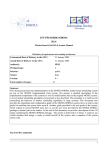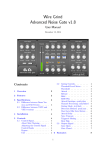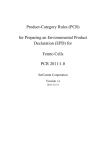Download User guide | Beta version | May 2013 - Eco footprint tool
Transcript
Reference Manual CEPE Eco Footprint Tool User guide | Beta version | May 2013 Contents 1 About the CEPE Eco Footprint Tool .................................................................................................. 3 2 How to use the Eco footprint tool .................................................................................................... 4 2.1 Product List ................................................................................................................................ 4 2.2 Product ...................................................................................................................................... 5 2.3 Process....................................................................................................................................... 6 2.4 Eco footprint .............................................................................................................................. 8 2.5 Account settings ...................................................................................................................... 10 Annex I Guidance on specific products ............................................................................................. 11 100% liquid paints ......................................................................................................................... 11 Two-component products ............................................................................................................. 11 Products that have used a longer grinding time than average ..................................................... 11 Annex II Description main impact categories .................................................................................... 12 Global Warming Potential (GWP).................................................................................................. 12 Ozone Depletion Potential (ODP) .................................................................................................. 12 Photochemical Ozone Creation Potential (POCP) ......................................................................... 12 Acidification Potential (AP)............................................................................................................ 12 Eutrophication Potential (EP) ........................................................................................................ 12 Abiotic Depletion Potential (ADP) ................................................................................................. 12 Dust and Particulate Matter (PM) ................................................................................................. 13 Human Toxicity Potential (HTP) .................................................................................................... 13 Freshwater Toxicity Potential ........................................................................................................ 13 Marine Aquatic Toxicity Potential ................................................................................................. 13 Terrestrial Eco Toxicity Potential ................................................................................................... 13 Annex III GHG protocol and energy use ............................................................................................ 14 Scope 1: Direct GHG emissions ..................................................................................................... 14 Scope 2: GHG emissions from imports of electricity, heat, or steam ........................................... 14 Scope 3: Other indirect GHG emissions ........................................................................................ 14 Reference Manual CEPE Eco Footprint Tool ©Ecomatters 2012 2 1 About the CEPE Eco Footprint Tool This Eco footprint tool was created by CEPE, the European council for the paint, Printing ink and artists’ colours Industry. It is available for CEPE members to calculate the Eco footprint of a specific paint. The tool is based on two databases: • • A coating manufacturing processes database, which includes the production processes of waterborne, solvent borne or powder paint. For this database data was collected at CEPE members sites. A database for coating raw materials. This data set was collected by CEPE with the help of its raw materials suppliers, and is now the most representative database for the coatings Industry. Disclaimer: The Eco footprints calculated with the Eco footprint tool are based on industry mean data and do not necessarily provide an accurate measure of the product’s true environmental footprint from a specific producer. The goal of the Eco footprint tool is to give an overview of the environmental impact of a kilogram of coating and is designed for coatings companies to do a quick impact screening for their products. The Eco footprints that are created do not automatically meet the requirements imposed on Life Cycle Assessments (LCAs) or Environmental Product Declarations (EPDs: FDES, carbon footprint, etc.) and therefore should not be used in market claims or external communication, without a transfer into the required format and a review by an LCA expert. The person or company creating an Eco footprint has full responsibility for the quality of the Eco footprint results and the way they are communicated. Information uploaded in the tool is protected by a personal login and password. It will be kept confidential and not be accessible by others. CEPE and Ecomatters (the developers of the tool) will preserve confidentiality of all data added to and processed by the tool. The raw material Life Cycle Inventory data is owned or licensed by CEPE. To get access to the full LCI database, please contact CEPE. The Eco footprint tool may be used by CEPE members only, and may exclusively be used to calculate the Eco footprints of member’s own coating products. Use of the tool and/or calculated results for commercial purposes is not permitted. By using the Eco footprint tool, you agree to be bound to these terms and conditions of use. Reference Manual CEPE Eco Footprint Tool ©Ecomatters 2012 3 2 How to use the Eco footprint tool The Eco Footprint Tool enables you to calculate a product’s eco footprint in three simple steps. This reference manual will guide you through this process for the first time. Let’s get started. 2.1 Product List When logged-in, you will be shown the Product list screen. To add a new product, click Add Product. 1. 2. 3. 4. 5. The name and description of the products are shown in the Product list. You can edit a product by clicking on its name. The green check sign or red – symbol indicates whether or not the data collection for a product is finalized. After finalization, the eco footprint can be created. Create Eco footprint: By clicking on the green EF-arrow, you will go directly to the Eco footprint screen to calculate the product’s eco footprint. Delete: To remove a product from the Product list, click on the red – symbol. Add product: To add another product, click on Add product. You will be directed to step 1 (Product). Reference Manual CEPE Eco Footprint Tool ©Ecomatters 2012 4 2.2 Product On the Product screen you will be asked to enter the general product information. 1. 2. 3. 4. Product details: enter the product name and give a short description. Scenario set up: the calculated eco footprint will report the environmental performance indicators associated with the production of 1 kg of product. Enter the surface coverage equivalent to this functional unit of 1 kg here, and select the correct production process for the product. Save & go to Process: Click to save the entered data and continue to step 2 (Process). Return to Product list: Click to return to the Product list. Entered data will not be saved. Reference Manual CEPE Eco Footprint Tool ©Ecomatters 2012 5 2.3 Process 2.3.1 Raw materials On the Process screen, you will be asked to provide information regarding the production process of the product. A minimum of three raw materials needs to be selected. The substance present in the highest quantity may not constitute more than 85% of the total product mass. 1. 2. 3. 4. You can filter the list of raw materials according to industry, category and subcategory, or you can search for a substance by entering its name in the search box. To add a raw material to the Bill of materials, select it in the list and click on the green + symbol. After adding a raw material to the Bill of materials, enter the actual used mass of the raw material in grams. Since the functional unit is 1 kg of product, the total must equal at least 1000 g. However, since waste is always generated the total will more likely be higher. To delete a raw material from the Bill of materials, click on the red - symbol. Reference Manual CEPE Eco Footprint Tool ©Ecomatters 2012 6 2.3.2 Electricity use and additional input parameters The values entered for Electricity use and Additional input parameters are provided by CEPE, and are the default values for the selected production process (production of solvent borne, water borne or powder coating). Manual alteration is not compulsory, but is allowed. 1. 2. 3. 4. 5. Electricity use: you may choose to adjust the default values for grinding time, power of grinding equipment and/or other power use. You must select an appropriate power source. Additional input parameters: you can unfold the Additional input parameters menu by clicking on the blue header. You may choose to adjust the default values for raw material transport, packaging material, direct emissions and auxiliaries of total production, heating, waste and/or forklifts. Save & go to Eco footprint: Click to save the entered data and continue to step 3 (Eco footprint). Return to Product: Click to return to the Product screen. Entered data will not be saved. Return to Product list: Click to return to the Product list. Entered data will not be saved. Reference Manual CEPE Eco Footprint Tool ©Ecomatters 2012 7 2.4 Eco footprint 2.4.1 Data overview On the Eco footprint screen, an Overview of the input data as well as an Eco footprint overview is given. 1. 2. Overview input data: The name, description, surface covering and production process of the coating are listed. This information will also be shown on the Eco Footprint Leaflet. Eco footprint overview: The main environmental impact categories, energy content, waste production and resource consumption are listed. This information will be shown as the summary of the product’s environmental performance on the full Eco Footprint Leaflet. Reference Manual CEPE Eco Footprint Tool ©Ecomatters 2012 8 2.4.2 Finalization product and extraction eco footprint 1. 2. 3. 4. 5. Finalize the Eco footprint: if the input data are entered correctly and you’ve read the disclaimer, you can finalize the product by checking the finalization checkbox. By finalizing the product, the Create footprint button will be enabled. Please note that if after checking the checkbox changes are made to the input data, the product automatically loses its ‘finalized’-status and must be finalized again before an updated eco footprint can be created. Extract the Eco footprint: Select the eco footprint format of choice. Create footprint: Click to extract the eco footprint in the chosen format. Return to Process: Click to return to the Process screen, to edit the input data. Return to Product list: Click to return to the Product list. Reference Manual CEPE Eco Footprint Tool ©Ecomatters 2012 9 2.5 Account settings On the Account settings screen, you can enter and/or edit your account information. 1. Login details: you can edit your username and/or password. 2. Company: you can edit the name of the company and upload a company logo. This logo will be printed onto the Eco Footprint Leaflet, with the dimensions 2.24 x 4.41 (height x width). Since larger images will be reduced to this size, please make sure the ratio of the height and width of the uploaded image is 1:2. The logo can be removed by clicking Remove image. 3. Contact information: you can edit the contact information and add a comment. Please note that the contact information entered here will be printed on the full Eco Footprint Leaflet or the Carbon Footprint. Reference Manual CEPE Eco Footprint Tool 10 ©Ecomatters 2012 Annex I Guidance on specific products 100% liquid paints For 100% liquid paints, select the solvent borne process, which approximates the actual manufacturing of these products the strongest. Two-component products Two-component products can be handled in two ways: 1) Looking at the components individually: create 2 Ecofootprints, one for a kilo of each component. When calculating the impact of the finally mixed components, apply the mixing ratio on the Ecofootprints Example: Component A and B have the associated Ecofootprints A and B (EFA and EFB), and are used in a 5 to 2 ratio. The Ecofootprint of the applied product is: EF”2-pack” = (EFA*5+EFB*2)/(5+2) 2) Looking at the combination: create one Ecofootprint respecting the ratio for each component when applied to get a kilo of the combined components. Products that have used a longer grinding time than average For products that have used a longer grinding time than average. two options are possible: 1) Level 1: Adjust the use of electricity according to specific knowledge of the grinding process: both grinding time and grinding power must be inputted. The electricity used elsewhere in the plant (such as heating, office electricity etc.) will keep the default values. 2) Level 2: the value of the total use of electricity for the whole site can be directly indicated in the box “total power use”. Reference Manual CEPE Eco Footprint Tool 11 ©Ecomatters 2012 Annex II Description main impact categories Global Warming Potential (GWP) Global Warming Potential is a relative measure of how much heat a greenhouse gas traps in the atmosphere over a specific time interval, commonly 20, 100 or 500 years. Reference unit: The GWP of a substance is expressed as a factor of the impact of carbon dioxide, whose GWP is standardized to 1 (g CO2 eq). Ozone Depletion Potential (ODP) The ozone depletion potential is the integrated change in total stratospheric ozone (the breakdown of the ozone layer in the upper atmosphere) per unit mass emission of a specific compound. Reference unit: The ODP of a substance is expressed as a factor of the impact of trichlorofluoromethane, whose ODP is standardized to 1 (μg CFC-11 eq). Photochemical Ozone Creation Potential (POCP) The photochemical ozone creation occurs due to chemical reactions brought about by the light energy of the sun. The reaction of nitrogen oxides with hydrocarbons in the presence of sunlight to form ozone is an example of a photochemical reaction. Reference unit: The POCP of a substance is expressed as a factor of the impact of ethylene, whose POCP is standardized to 1 (mg C2H4 eq). Acidification Potential (AP) Examples of chemical compounds responsible for the acidification potential are: sulphur dioxide (SO2), nitrogen oxides (NOx) and ammonia (NH3). Acid depositions have negative impacts on natural ecosystems and the man-made environment including buildings. The main sources for emissions of acidifying substances are agriculture and fossil fuel combustion used for electricity production, heating and transport. Reference unit: The AP of a substance is expressed as a factor of the impact of sulfur dioxide, whose AP is standardized to 1 (g SO2 eq). Eutrophication Potential (EP) Eutrophication is the excessive enrichment of water and continental surfaces with nutrients, and the associated adverse biological effects. Reference unit: The EP of a substance is expressed as a factor of the impact of ionic phosphate, whose EP is standardized to 1 (mg PO43- eq). Abiotic Depletion Potential (ADP) Abiotic depletion potential measures the gradual depletion of non-renewable non-organic materials. Reference unit: The ADP of a substance is expressed as a factor of that of elemental antimony, whose depletion is standardized to 1 (mg Sb eq). Reference Manual CEPE Eco Footprint Tool 12 ©Ecomatters 2012 Dust and Particulate Matter (PM) Dust and particulate matter includes acids (such as nitrates and sulphates), organic chemicals, metals, and soil or dust particles. PM is a potential health hazard through risk of inhalation. Reference unit: The PM emitted by a substance is expressed as a factor of the emission of particulate matter with a diameter of 10 micrometers, which is standardized to 1 (mg PM10 eq). Human Toxicity Potential (HTP) The human toxicity potential measures exposure of humans to toxic substances by breathing (air), drinking (water) and ingestion (food, soil particles). Reference unit: The HTP of a substance is expressed as a factor of the impact of 1,4-dichlorobenzene, whose HTP is standardized to 1 (g 1,4-DB eq). Freshwater Toxicity Potential The freshwater toxicity measures the exposure of freshwater flora and fauna to toxic substances. Reference unit: The FTP of a substance is expressed as a factor of the impact of 1,4-dichlorobenzene, whose FTP is standardized to 1 (g 1,4-DB eq). Marine Aquatic Toxicity Potential The marine toxicity measures the exposure of marine flora and fauna to toxic substances. Reference unit: The marine aquatic toxicity potential of a substance is expressed as a factor of the impact of 1,4-dichlorobenzene, whose marine aquatic toxicity potential is standardized to 1 (kg 1,4DB eq). Terrestrial Eco Toxicity Potential The terrestrial eco toxicity potential measures the exposure of terrestrial flora and fauna to toxic substances. Reference unit: The terrestrial eco toxicity potential of a substance is expressed as a factor of the impact of 1,4-dichlorobenzene, whose terrestrial eco toxicity potential is standardized to 1 (g 1,4-DB eq). Reference Manual CEPE Eco Footprint Tool 13 ©Ecomatters 2012 Annex III GHG protocol and energy use To help delineate direct and indirect emissions sources, improve transparency, and provide utility for different types of organizations with different needs and purposes, three ‘scopes’ are defined for green house gas (GHG) accounting and reporting purposes. The GHG Protocol recommends that companies account for and report scopes 1 and 2 at a minimum. Scope 1: Direct GHG emissions Scope 1 accounts for direct GHG emissions from sources that are owned or controlled by the reporting company. Scope 1 emissions are principally the result of the following activities: • production of electricity, heat, or steam • physical or chemical processing2, e.g. cement, adipic acid and ammonia manufacture • transportation of materials, products, waste, and employees, e.g. use of mobile combustion sources, such as: trucks, trains, ships, airplanes, buses, and cars • fugitive emissions: intentional or unintentional releases such as: equipment leaks from joints, seals; methane emissions from coal mines; HFC emissions during the use of air conditioning equipment; and CH4 leakages from gas transport Scope 2: GHG emissions from imports of electricity, heat, or steam Scope 2 accounts for indirect emissions associated with the generation of imported/purchased electricity, heat, or steam. Emissions attributable to the generation of exported/sold electricity, heat, or steam should be reported separately under supporting information. These emissions must also be included in scope 1. To increase data transparency, emissions data associated with imported and exported electricity, heat, or steam should not be netted. The emissions associated with the generation of imported electricity, heat, or steam are a special case of indirect emissions. For many companies, electricity usage represents one of the most significant opportunities to reduce GHG emissions. Companies can reduce their use of electricity and/or use it more efficiently by investing in energy efficient technologies. Additionally, emerging green power markets3 enable some companies to switch to less GHG intensive electricity suppliers. Companies can also install an efficient cogeneration plant on site to replace the import of more GHG intensive electricity from the grid. Scope 2 facilitates the transparent accounting of such choices. Scope 3: Other indirect GHG emissions Scope 3 allows for the treatment of other indirect emissions that are a consequence of the activities of the reporting company, but occur from sources owned or controlled by another company, such as: • employee business travel • transportation of products, materials, and waste Reference Manual CEPE Eco Footprint Tool 14 ©Ecomatters 2012 • outsourced activities, contract manufacturing, and franchises • emissions from waste generated by the reporting company when the point of GHG emissions occurs at sources or sites that are owned or controlled by another company, e.g. methane emissions from landfilled waste • emissions from the use and end-of-life phases of products and services produced by the reporting company • employees commuting to and from work • production of imported materials Reference Manual CEPE Eco Footprint Tool 15 ©Ecomatters 2012
























